 |
October 2016
|
October 2016 // Volume 54 // Number 5 // Research In Brief // v54-5rb1
Assessing Nature-Based Recreation to Support Economic Development and Environmental Sustainability Extension Programs
Abstract
In support of community development, natural resource, and other Extension programs, the research reported here aimed to identify current and potential outdoor recreational opportunities in the St. Johns River Basin, an inland area in northeastern Florida. We identify the characteristics of the visitors participating in the recreational activities and discuss opportunities to enhance tourism experiences. Similar research can be implemented in other U.S. regions to document the benefits provided by water resources to local and regional economies.
Introduction and Objective
Extension activities that center on nature-based recreation contribute to several Cooperative Extension priorities. Nature-based tourism programs can (a) strengthen and diversify rural economies by creating new revenue-generating and employment opportunities (Honadle, 1990; Schroeder, 2004; Tweeten, Leistritz, & Hodur, 2008); (b) reinforce the ties between communities and natural resources to motivate conservation (Marcouiller, 1999; Oladele, 2012; Otto, Monchuk, Jintanakul, & Kling, 2007); and (c) contribute to family fun, healthful living, and youth development by facilitating outdoor physical activities and active learning (Bedimo-Rung, Mowen, & Cohen, 2005). If successful, these Extension activities also can generate economic impacts for the local communities.
To help address these priorities and potentially increase tourism-based economic impacts, Extension personnel need to understand how natural resources are currently being used and how to increase the knowledge, appreciation, and use of these resources. Information about nature-based recreation collected by state and federal agencies typically focuses on particular sites (e.g., parks) or specific types of recreation (e.g., fishing) (National Park Service, n.d.; U.S. Fish and Wildlife Service, n.d.). For a geographically connected area, such as a river basin, visitation data for individual sites could lead to overestimation (if tourists visit more than one site during a day-trip) or underestimation (if tourists visit areas with no access verification). To avoid these problems, assess visitation of a river basin or a region, and account for visitation by local residents (whose preferences for and use of local areas are often underestimated in recreational valuation studies), public surveys of the specific region are needed (Pennington-Gray, Thapa, & Holland, 2002; Tovar & Lockwood, 2008).
To examine freshwater-based recreation in northeastern Florida, we surveyed Florida residents about their visits to the St. Johns River (SJR) Basin. The SJR, the longest river in Florida, was designated as one of 14 American Heritage Rivers on the basis of its historical and cultural significance (National Park Service, 2005). Also, the SJR was identified as one of the most endangered rivers in the United States (Kober & Armingeon, 2008). The SJR Basin offers a range of recreational sites and opportunities. Information about the knowledge and use of freshwater resources in the area, including tourism and recreation activities, should facilitate Extension programming in engaging local communities in environmental conservation.
Methods
A telephone survey of a random sample of Florida residents (at least 18 years old) was conducted in September and October 2014. The geographic scope was defined to include 49 of the total 67 counties in Florida that are within a day-trip's distance from the SJR Basin to ensure responses of local residents. Phone numbers were identified using random digit dialing. The survey continued until the targeted number of 500 complete responses was obtained and three Florida regions were equally represented (166 responses from the northern region, 168 from the central region, and 166 from the southern region).
The content-related survey questions were developed in discussions with representatives of multiple environmental and recreation groups. The questionnaire focused on nature-based recreation and included questions about respondents' recreational trips, travel distances, and donations for environmental causes.
The responses were used to determine key metrics to characterize the population, such as the percentages of the population who enjoy recreational activities in general and SJR Basin recreational activities in particular. Findings that correlate the sociodemographic characteristics of respondents with their responses related to recreation were examined using logistical regression analysis, which is a standard way to model binary and multiple-choice responses, and likelihood ratio chi-square tests (Kennedy, 2008) that were conducted using the SAS statistical package (SAS Institute Inc., 2015).
Results
Respondents' sociodemographic information is summarized and compared to U.S. Census data for Florida in Table 1. In comparison with regional and Florida populations, the sample of respondents included higher percentages of females, older residents, and more educated and affluent residents (with higher income homeowners). The locations of respondents who were visitors to the SJR Basin are shown in Figure 1 and discussed further below.
| Variable | Telephone survey | Florida | |
| Number usable of responses | Percentage of respondents | ||
| Female | 500 | 61.5% | 51.8%a |
| Caucasian | 482 | 82.5% | 78.6%a |
| Age: 18–44 | 480 | 11.7% | 43.0%a |
| Age: 45– 64 | 480 | 40.4% | 34.2%a |
| Age: 65 and older | 480 | 47.9% | 22.8%a |
| Education: graduated from high school (age 25+) | 497 | 98.1% | 87.2%a |
| Household income: less than $35,000 | 376 | 23.1% | 37.7%a |
| Household income: $35,000–$49,999 | 376 | 22.6% | 15.3%a |
| Household income: $50,000 or more | 376 | 54.3% | 47.0%a |
| Florida full-time residents | 500 | 97.6% | |
| Average years lived in Florida (for full-time residents) | 488 | 33.8 | |
| Average household size | 489 | 2.4 | 2.7a |
| Type of residence: mobile home | 497 | 7.8% | 9.1%b |
| Home ownership | 494 | 85.2% | 67.8%a |
| aData for 49 counties surveyed (U.S. Census Bureau, 2015, 2014, 2013a, 2013b). bData for the state as a whole (U.S. Census Bureau, 2013a, 2013b). | |||
Figure 1.
St. Johns River (SJR) Basin, Selected Florida Counties, and Zip Codes,
with Visitors to SJR Basin
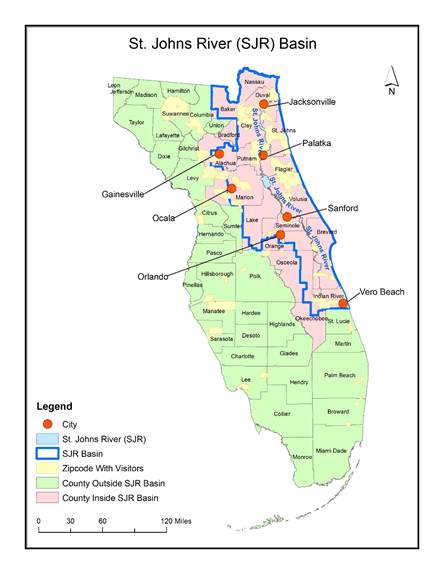
Table 2 summarizes the key questions, methods of analysis, and findings. Complete results of the analysis are available from us upon request; in this article, however, we describe the relationships identified as statistically significant at the 10% level or less.
| Question letter (topic) | Survey question (answer choices) | Method of analysis | Findings |
| A (recreationists and non-recreationists) | For the purposes of this survey, we'd like you to focus on outdoor activities in inland areas instead of those at the beach or in the ocean. This includes activities like hiking, biking, bird watching or wildlife viewing, horseback riding or hunting, and freshwater-related activities like fishing, boating, or swimming on freshwater such as lakes, rivers, or streams. In the past 12 months, have you or anyone in your household traveled more than 10 miles from home to participate in an inland outdoor activity like those just described? (Yes, No, Do not know, Refuse to answer) | Logistic regression analysis estimating the likelihood of Yes responses as a function of respondents' gender, race, age, household income, household size, education, full/part-time residence in Florida, duration of residence in Florida, and type of home (owned, rented, mobile, or other) | Younger respondents and respondents with higher income were more likely to answer Yes to the question (α = 5% and α = 10%, respectively). The other variables did not have statistically significant effects on the responses. |
| B (recreation in SJR Basin specifically) | We are interested in recreation in freshwater areas along the Florida SJR Basin, a region near the Atlantic Coast stretching from Jacksonville to Vero Beach. This area includes Big Talbot Island, Ocala National Forest, Lake George, Silver Springs, Lake Monroe, Lake Washington, and Blue Cypress. Were any of your trips to participate in inland outdoor recreational activities to the SJR Basin area just described? (Yes, No, Do not know, Refuse to answer) | Logistic regression analysis estimating the likelihood of Yes responses among recreationists as a function of respondents' gender, race, age, household income, household size, education, duration of residence in Florida, and type of home (owned, rented, mobile, or other) | Male recreationists were more likely to answer Yes to the question (α = 1%). The other variables did not have statistically significant effects on the responses. |
| C (reasons for not recreating in SJR Basin) | Is there any particular reason why none of your trips involving inland outdoor recreation were to this area? (Yes, No, Do not know, Refuse to answer) [if Yes] Why didn't you visit the SJR Basin area? [Mark all that apply.] (Too far away/distance, Not familiar with the area, Prefer other areas for inland recreation, Costs too much in that area, Poor water quality, Not enough options/facilities in that area, Other [please describe], Not sure, Prefer not to answer) | Summary statistics | Among the answer choices given, "Too far away/distance" was cited the most frequently. |
| D (type of recreational activity in SJR Basin) | What was your primary inland outdoor recreational activity on that most recent trip to the SJR Basin area? [Mark one response.] (Nonmotorized boating [i.e., canoeing or kayaking]; Motorized boating; Fishing from a pier, boat, or shore; Swimming, snorkeling, or diving; Camping; Hunting; Hiking or geocaching; Bird watching or wildlife viewing; Horseback riding; Sports; Other; Not sure; Prefer not to answer) | Likelihood ratio χ-square tests; responses by age categories, income categories, and gender | More males reported swimming, snorkeling, or diving than females (α = 10%); more respondents aged 45–64 enjoyed bird watching and wildlife viewing than respondents from the other age categories (α = 1%); lack of statistically significant relationship for the other variables was partially explained by the small number of observations. |
| E (number of trips to SJR Basin) | How many trips to participate in inland outdoor recreational activities in the SJR Basin area have you made in the past 12 months? | Median response | Median number of trips was three. |
| F (day-trips or overnight trips to SJR Basin) | Was this trip a day-trip, in which you returned home the same day, or did you spend one or more nights away from home? (Day trip, Overnight, Not sure, Prefer not to answer) | Percentage respondents | 36% stayed overnight. |
| G (number of nights spent on last trip to SJR Basin) | How many nights did you spend away from home on that trip? | Median response | Median length of stay was 2 nights. |
| H (donations for environmental causes) | In the past 5 years, have you contributed time or money to environmental causes? (Examples include buying a specialty license plate, making direct donations, or volunteering for environmental organizations.) (Yes, No, Do not know, Refuse to answer) | Logistic regression analysis estimating the likelihood that Yes responses can be explained by recreating in general and in SJR Basin specifically and by respondents' gender, race, duration of Florida residency, and concerns related to the quality of water resources in their home counties | Recreationists visiting SJR Basin were more likely to answer Yes (α = 5%). Similarly, those residing in Florida for a longer time and those concerned about water quality in their home counties were more likely to answer Yes (α = 10% and α = 1%, respectively). In contrast, Caucasians and males were less likely to answer Yes (α = 1% and α = 5%, respectively) to donating for environmental causes. Being a recreationist did not have a statistically significant effect. |
Participation in Nature-Based Recreation
As shown in Figure 2, 39.2% of respondents indicated that in the preceding 12 months they or others in their households had traveled more than 10 mi from home to the SJR Basin or other areas to participate in an inland outdoor recreational activity (these respondents are referred to herein as "recreationists"). The likelihood of participation in nature-based receation decreased with age (α = 5%; based on a logistic regression analysis) (Table 2, question A; Figure 2), whereas it increased with income (α = 1%), with the annual household income of most recreationists being $50,000 or more (Figure 3).
Figure 2.
Incidence of Recreationists and Non-recreationists in the Sample and by Age Category

Figure 3.
Respondents' Income Distribution for Recreationists and Non-recreationists
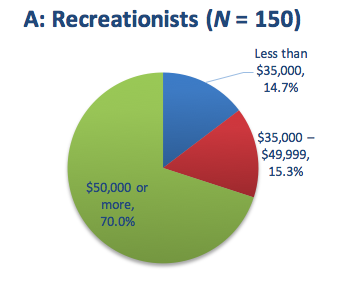
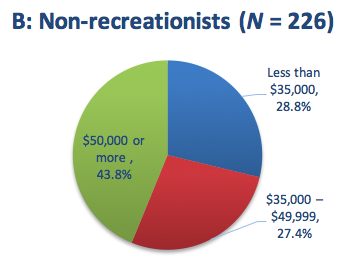
Outdoor Recreation in the SJR Basin
Figure 4 shows that among the recreationists, 39.8% indicated that they or members of their households had traveled specifically to the SJR Basin for outdoor recreational activities in the preceding 12 months (a figure that corresponds to 15.6% of the total number of survey responses). Fewer female recreationists had visited the SJR Basin (logistic regression analysis; α = 1%) (Table 2, question B; Figure 4). Visitors enjoyed a variety of recreational activities, with the primary activities being fishing; swimming, snorkeling or diving; and hiking or geocaching (Figure 5).
Figure 4.
Recreationists' Participation in Inland Outdoor Recreational Activities in the Preceding
12 Months in the St. Johns River (SJR) Basin, by Gender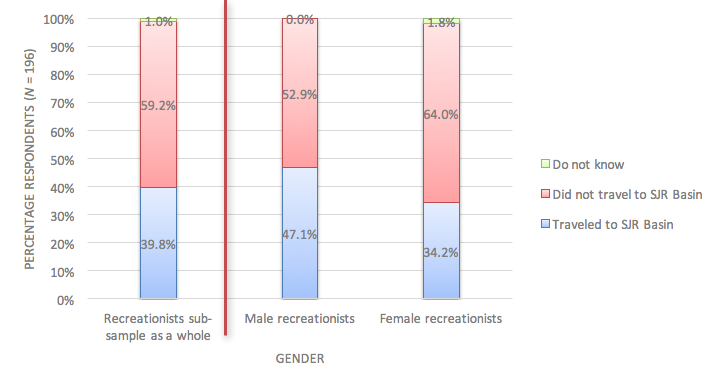
Figure 5.
Responses to the Question "What Was Your Primary Inland Outdoor Recreational Activity
on That Most Recent Trip to the St. Johns River Basin Area?"—Ordered by Frequency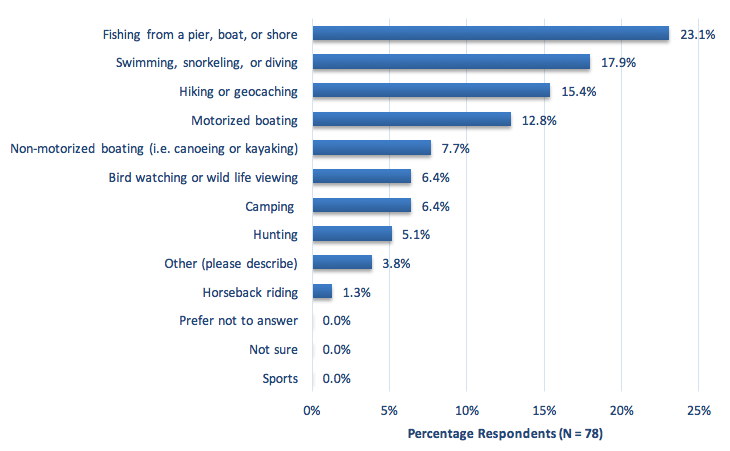
The total population in the 49 counties surveyed was 14.2 million (Florida Office of Economic and Demographic Research, 2012), and assuming on the basis of the survey responses that 15.6% of this population had traveled to the SJR Basin, 2.2 million people had traveled more than 10 mi from home to enjoy outdoor recreational activities in the SJR Basin in the preceding 12 months. Moreover, we may have underestimated the actual number of recreationists in the SJR Basin, as our sample included fewer males and younger respondents than the total population in the region.
Additionally, the number of visitor-days may be more than three times higher than the estimated number of people who had visited the area, as 76.6% of those who had visited the SJR Basin reported having made more than one trip to the Basin (overall sample median was three trips), and 35.9% reported having stayed in the region overnight on their most recent trip, with a median length of stay of 2 nights (Table 2, questions E–G).
Enhancing Outdoor Recreation Opportunities
Among recreationists, 59.2% had not traveled for inland outdoor recreational activities to the SJR Basin in the preceding 12 months (see Figure 4), indicating a market expansion opportunity. Given the regional population of 14.2 million, this translates into 3.3 million people (and even more visitor-days). Some of those who had not traveled to the SJR Basin offered specific reasons, with distance being the most often cited (Table 2, question C). Several respondents mentioned that there were not enough recreational options or facilities in the SJR Basin. Because most of the outdoor recreational opportunities are located in the middle and northern areas of the SJR Basin (see the zip code areas where visitors live, Figure 1), increasing the opportunities throughout the SJR Basin, especially in the southern basin area, could address respondents' concerns related to both distance and lack of facilities.
Fewer female recreationists than male recreationists had visited the SJR Basin (see Figure 4). Because of this circumstance, tourism development in the area should focus on family-oriented programs that include family members of all ages and both genders. In developing such opportunities, the emphasis should not be on swimming, snorkeling, or diving opportunities similar to existing opportunities in the SJR Basin, as female visitors participate in such activities to a smaller extent (only 11% of females reported participation, compared with 25% of males; likelihood ratio chi-squared test; α = 10%; Table 2, question D).
Furthermore, developing additional bird watching and wildlife viewing opportunities may increase the number of visitors aged 45–64 (14% of visitors of this age group participated in bird watching and wildlife viewing, compared with 0% among those younger or older; likelihood ratio chi-squared test; α = 1%; Table 2, question D). Finally, although nationwide 20% of outdoor participants kayak (Outdoor Foundation, 2013), the percentage of respondents participating in nonmotorized boating in the SJR Basin was only about 8% (see Figure 5), indicating another market expansion opportunity.
Donations for Environmental Causes
The majority (63.4%) of the surveyed respondents who had visited the SJR Basin had donated time or money for environmental causes in the preceding 5 years (compared to 40.0% in the rest of the sample; α = 5%; based on the logistic regression analysis; Table 2, question H). Such donation behaviors by recreationists may be related to a proenvironmental world view as well as to better knowledge of the critical state of local natural resources (compared to that of non-recreationists).
Conclusions
Nature-based recreation can be an important economic engine for local communities by attracting millions of visitors. Meanwhile, communities often lack information about the extent and importance of nature-based recreational tourism in their areas, hindering rational community planning and development decisions. Information about the value of services provided by freshwater resources, including tourism and recreational services, can strengthen both community development and the natural resource protection message delivered by Cooperative Extension programs. At the same time, expanding nature-based tourism can increase public awareness of natural resource issues and management, creating a sense of connection to a place and contributing to healthful living and youth development goals. With regional Extension programs emphasized in many states, evaluating visitation to a local region or a basin (as opposed to a particular recreational site) can facilitate regional cooperation of county agents.
Recreationists' active participation in environmental resource protection makes them an important ally in natural resource management and policy making. Expanding nature-based tourism opportunities and involving more people in outdoor recreation may increase support for natural resource protection programs. It is apparent that there are opportunities for females and visitors of all ages that have not been fully explored throughout the SJR Basin, particularly in the southern basin area. For other regions, similar studies can be conducted to assist in marketing local nature-based recreation and identifying opportunities for expanding opportunities.
As a next step, the information on respondents' most recent visit will be analyzed using the travel cost method (Hanley, Shogren, & White, 2007) to estimate the economic value derived from local residents' nature-based recreation in the SJR Basin. The preliminary findings indicate that the recreational benefits provided by the SJR Basin to Florida residents exceed $170 million annually (Ehlrich, Bi, Borisova, & Larkin, 2016).
Acknowledgments
We would like to acknowledge funding from the Florida State Legislation Appropriation, received through a subcontract from the University of North Florida. We are appreciative of the feedback for the research provided by recreation and environmental protection groups operating in the SJR Basin and surrounding counties in Florida. We also appreciate help with the survey design and administration by the Florida Survey Research Center (University of Florida). We appreciate suggestions for this paper by Carol Fountain, University of Florida, and by the three anonymous Journal of Extension reviewers.
References
Bedimo-Rung, A. L., Mowen, A. J., & Cohen, D. A. (2005). The significance of parks to physical activity and public health. American Journal of Preventive Medicine, 28(Supplement 2), 159–168.
Ehlrich, O., Bi, X., Borisova, T., & Larkin, S. (2016, February 6–9). A latent class analysis of public attitudes toward water resources: Implications for recreational demand. Paper presented at Southern Agricultural Economics Association 2016 Annual Meeting, San Antonio, Texas. Retrieved from http://ageconsearch.umn.edu/handle/230058
Florida Office of Economic and Demographic Research. (2012). Florida 2010 census detailed county profiles. Retrieved from http://edr.state.fl.us/Content/population-demographics/2010-census/data/index.cfm
Hanley, N., Shogren, J. F., & White, B. (2007). Environmental economics in theory and practice. New York, NY: Oxford University Press.
Honadle, B. W. (1990). Extension and tourism development. Journal of Extension, 28(2) Article 2FEA1. Available at: https://www.joe.org/joe/1990summer/a1.php
Kennedy, P. (2008). A guide to econometrics (6th ed.). Malden, MA: Blackwell Publishing.
Kober, A., & Armingeon, N. (2008, December 11). Future of the St. Johns River, one of America's most endangered rivers of 2008, still hangs in the balance: Eight months after 'Most endangered river' listing, action still needed to improve water management. American Rivers. Retrieved from http://www.americanrivers.org/newsroom/press-releases/future-of-st-johns-river-one-of-americas-most-endangered-rivers-of-2008-still-hangs-in-the-balance/
Marcouiller, D. (1999). Water issues in Wisconsin—The economic value of water: An introduction. G3698-1. Retrieved from http://www.wisconsinlakes.org/attachments/article/43/Intro_Econ-Value-of-Water_UWEX-G3698.pdf
National Park Service. (n.d.). Economics. Washington, DC: National Park Service. Retrieved from http://www.nature.nps.gov/socialscience/economics.cfm
National Park Service. (2005). Rivers: More about rivers: Designations programs of NPS rivers with examples. Washington, DC: National Park Service. Retrieved from http://www.nps.gov/ncrc/rivers/projpg/nana1.htm
Oladele, O.I. (2012). Knowledge levels and perceived effect of ecosystem services and valuation on extension delivery in North West Province, South Africa. Journal of International Agricultural and Extension Education, 19(1), 42–53.
Otto, D., Monchuk, D., Jintanakul, K., & Kling, C. (2007). The economic value of Iowa's natural resources. Retrieved from https://www.card.iastate.edu/environment/items/DNR-Amenity.pdf
Outdoor Foundation. (2013). Outdoor recreation participation report. Retrieved from http://www.outdoorfoundation.org/pdf/ResearchParticipation2013.pdf
Pennington-Gray, L., Thapa, B., & Holland, S. (2002). Florida residents' constraints to parks and public lands visitation: An assessment of the validity of an intrapersonal, interpersonal, and structural model. World Leisure Journal, 44(4), 51–60.
SAS Institute Inc. (2015). SAS 9.4 software. Cary, NC: SAS Institute.
Schroeder, T. (2004). Motivations of resource-based tourism operators in North Dakota. Journal of Extension, 42(6) 6FEA6. Available at: https://www.joe.org/joe/2004december/a6.php
Tovar, C., & Lockwood, M. (2008). Social impacts of tourism: An Australian regional case study. International Journal of Tourism Research, 10, 365–378. doi:10.1002/jtr.667
Tweeten, K., Leistritz, L., & Hodur, N. (2008). Growing rural tourism opportunities. Journal of Extension, 46(2) 2FEA2. Available at: https://www.joe.org/joe/2008april/a2.php
U.S. Census Bureau. (2013a). 2011–2013, 3-Year American community survey. Income in the past 12 months (in 2013 inflation-adjusted dollars). Retrieved from http://factfinder.census.gov/faces/tableservices/jsf/pages/productview.xhtml?pid=ACS_13_3YR_S1901&prodType=table
U.S. Census Bureau. (2013b.) Florida quick facts from the US census bureau. Retrieved from http://quickfacts.census.gov/qfd/states/12000.html
U.S. Census Bureau. (2014). 2010–2014 American community survey. B11012: Household Type by Tenure - Universe: Households. Retrieved from http://factfinder.census.gov/faces/tableservices/jsf/pages/productview.xhtml?pid=ACS_14_5YR_B11012&prodType=table
U.S. Census Bureau. (2015). American fact finder: Download center. Retrieved from http://factfinder.census.gov/faces/nav/jsf/pages/download_center.xhtml#none
U.S. Fish and Wildlife Service. (n.d.). National survey of fishing, hunting, & wildlife-associated recreation (FHWAR). Retrieved from http://www.census.gov/prod/www/fishing.html




